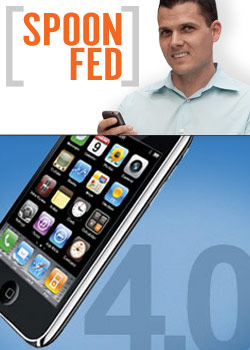iPhone OS 4: Pushing the Envelope or Playing Catch-Up?

If you scan through the list of “tentpole” features for the next version of the iPhone OS coming this summer, only a few stand out as unique. iAd is certainly one, and is designed to make ads more interactive. In fact, these units look a lot like apps, which developers and marketers will love. No more boring banner ads that most users just ignore. Another standout feature is Game Center, which will bring a social gaming network to the iPhone, enabling Apple to compete directly against the Xbox Live goodness coming to Windows Phone 7. But what about the new features of iPhone OS 4 that the competition offers today, such as multitasking or a unified inbox. Are Apple’s implementations really better?
Let’s start with multitasking. iPhone OS 4 will enable iPhone 3GS and third-generation iPod touch users (sorry, iPhone 3G owners) to quickly switch applications using a cleverly designed dock. Sounds a lot like webOS, right? Wrong.
You don’t see the whole app, as you do on Palm’s platform, just icons that you can tap. That’s not as pretty, but it will likely save more battery life. As for Android, there’s a reason that Advanced Taskiller is in the top 20 list of apps. The OS knows how to multitask, but not necessarily juggle resources in the most efficient way. This is the advantage of Apple making its own hardware and software.
BlackBerry has been doing multitasking for ages, and I like the way it presents small icons when you want to switch apps. However, performance takes a serious hit when you have multiple apps running. Windows Phone 7 will offer background tasks, but it doesn’t seem as though you’ll be able to see all open programs at a glance. The user will have less control.
With iPhone OS 4, you’ll also finally be able to listen to Pandora while you perform other tasks and receive incoming Skype calls—even if the phone is locked. Other platforms multitask with audio just as well, but Android doesn’t let you control playback when you’re not in the app. webOS does, and you can also vote songs up or down using its notification window, so I actually prefer this implementation. Skype Mobile for Verizon Wireless (available on BlackBerry and Android devices) lets you receive calls in the background, but you can’t use the app to make calls when you’re overseas, and you can’t place domestic calls over Skype.
iBooks for iPhone 4 really just looks and feels like a shrunken iPad version, which is nice but far from groundbreaking. Another welcome but long overdue enhancement is a unified e-mail inbox. I’m sure a lot of iPhone owners are sick of having to continually back out of their inbox just to check another account. This is an area where Apple seems to be playing catch-up, giving users the ability to display messages from multiple accounts in one place. And Google had threaded messaging ages ago, although it could certainly be more intuitive.
Folders sounds like another me-too feature that other smart phone owners have had for a long time, but Apple makes it easier to group apps together. You just drag one icon on top of another to create a folder. On Android, for example, you have to long press on the screen, create a new folder, and then drag icons to it. Plus, the iPhone’s folder icons actually show you what’s in them, as opposed to a lame stock folder graphic. And you can move these folders to the Dock as favorites.
Stay in the know with Laptop Mag
Get our in-depth reviews, helpful tips, great deals, and the biggest news stories delivered to your inbox.
So what’s missing? Although Apple didn’t show all of the 100-plus expected features of iPhone OS 4, we didn’t see much in the way of Facebook or Twitter integration when it comes to contacts or calendars. There also doesn’t seem to be a way to have instant messaging conversations in the background. I’d also like to see a way to save documents and make them searchable right from the main menu, and a way to wirelessly sync the iPad and iPhone without having to go through your PC or iTunes.
As far as the competition goes, Android continues to lead when it comes to advanced voice control and free built-in GPS. We also prefer Android’s less intrusive notification system, as opposed to Apple’s pop-ups. Windows Phone 7 still seems to have momentum in that the home screen and various hubs are completely customizable based on what the user cares about most. webOS does some of what iPhone OS 4 promises well, but needs to do some work in the speed and battery life departments.
In some respects, Apple is catching up. But at least based on what has been shown thus far, Apple’s execution is more polished and intuitive than the competition. Moreover, when iPhone OS 4 hits the iPad this fall, the multitasking capability alone will make it a much better productivity machine. It doesn’t look like it on the surface, but Apple is indeed pushing the envelope because it introduces the functions users have been asking for in a more thoughtful way.
Editor-in-chief Mark Spoonauer directs LAPTOP's online and print editorial content and has been covering mobile and wireless technology for over a decade. Each week Mark's SpoonFed column provides his insights and analysis of the biggest mobile trends and news. You can also follow him on Twitter.

